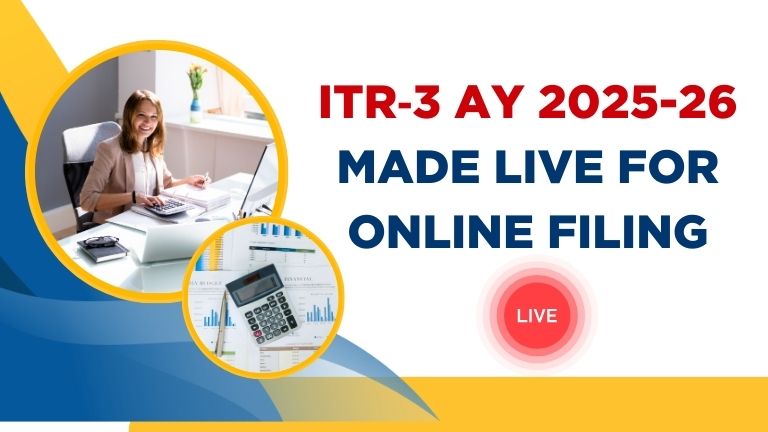On 30 July 2025, the Income Tax Department officially enabled online filing of ITR‑3 online for Assessment Year 2025–26 (Financial Year 2024‑25) via its e‑filing portal. This means individuals and Hindu Undivided Families (HUFs) with business or professional income, income from share trading or futures & options (F&O), capital gains, unlisted equity investments, or those who are company directors, can now file the form electronically without manually uploading utilities.
This implementation comes after delays in the release of ITR‑3 utilities in prior years. Taxpayers can externally verify their returns through digital signature, Aadhaar OTP, or e‑verification code (EVC), or by sending ITR‑V within 30 days as specified.
Who Must File ITR 3?
These are persons running their own proprietary concerns or expanding that income through freelance activities, i.e., a professional accountant, engineer, doctor, architect, etc. It would include partners working or drawing a salary, commission, or profit share in the firm; directors of companies; and people interested in unlisted shares.
New Updates in ITR‑3 for AY 2025‑26
Several important updates have been introduced in the form and excel utility for this filing season. Taxpayers should pay close attention to:
1. Profession-specific codes
New codes have been introduced for digital earners:
- Influencers now must use code 16021
- F&O traders use 21010
- Betting-related earnings use 21009
2. Regime confirmation (Form 10‑IEA)
Taxpayers must declare whether they are continuing or opting out of the new tax regime under section 115BAC using Form 10‑IEA
3. Capital‑gains split
Capital gains must now be reported separately for transactions before and after 23 July 2024, per financial act amendments
4. Asset & liability threshold increase
If the combined value of assets or liabilities exceeds ₹ 1 crore, taxpayers must report them in detail
5. Section 44BBC addition
Cruise and specialized cruise business incomes must use the newly added section 44BBC in Schedule BP
How to File ITR‑3 Live
In the Income Tax e-filing portal, one must provide the representation of a declarant and confirm eligibility before proceeding to choose ITR 3. Then, the requisite information must be inputted; these are details including personal information, income sources, deductions, audit details (if applicable), and breakdown of capital gains. Some information, such as PAN, AIS, and bank details, as well as Form 26AS data, is pre-filled, and one must verify and amend them if necessary.
Upon filing, the returns must be verified through:
- A digital signature (made compulsory where an audit needs to be conducted under section 44AB),
- Aadhaar OTP, EVC, or
- ITR paper form V signed and posted to the Central Processing Centre, Bangalore, within 30 days.
Who Should Not Use ITR‑3?
The e-verification procedure is quickest and circumvents delays in mailing.
Taxpayers whose only income is salary, pension, rent, interest, or capital gains (and who qualify under standard ITR‑1, ITR‑2, or even presumptive ITR‑4) should not file ITR‑3.
Conclusion
ITR 3 Now Live is now fully functional and essential for many taxpayers with business, professional, trading, capital gains, or directorship income. The form includes new profession codes, stricter capital gains and asset reporting rules, and mandatory regime declaration. Use the e‑filing portal, pick the correct income heads, and verify your return promptly. If you’re unsure, consult a tax expert or chartered accountant to avoid penalties.
FAQs
Q1. What is ITR 3 Now Live?
ITR 3 is a tax return form for individuals and HUFs with profits or gains from business or profession, including partners’ remuneration or income from unlisted equity shares. It’s used if you are not eligible to file ITR‑1, ITR‑2 or ITR‑4.
Q2. When did ITR 3 made Live now begin?
Online filing of ITR 3 became available on 30 July 2025 for AY 2025‑26 (FY 2024‑25). The Income‑Tax Department officially enabled the e‑filing and verification system via Aadhaar OTP, digital signature, or EVC on that date.
Q3. Who must file ITR 3?
Individuals or HUFs earning business or professional income, including freelancers, proprietors, company directors, partners, traders (F&O), investors in unlisted shares, or a mix of income heads must file ITR 3 if not eligible for simpler forms.
Q4. Are part‑time professionals eligible?
Yes. Even occasional or part‑time freelance or professional earnings are classified as business income and require ITR 3 online. You cannot use ITR 2 or ITR 1 if you have any business or professional income, however small.
Q5. What are the new profession codes?
From AY 2025‑26, new profession codes include Influencers (code 16021), F&O traders (code 21010), and betting/gambling income (code 21009). These must be selected when filling ITR 3 or ITR 4 where applicable under the new classification rules.
Q6. How are capital gains reported?
Capital gains must be reported separately for transactions before and after 23 July 2024, reflecting amendments in the Finance Act. This split ensures correct application of updated LTCG rates and indexation benefits.
Q7. Do I need to disclose assets?
Yes. Under ITR 3 now live for AY 2025‑26, you must report your assets and liabilities in detail if their total value exceeds ₹1 crore. The threshold has been raised from ₹50 lakhs.
Q8. How to verify the return?
You can e‑verify using digital signature, Aadhaar OTP, or electronic verification code (EVC). Alternatively, you may sign and mail the ITR‑V form to CPC Bangalore within 30 days. Digital signatures are mandatory for audited cases.
Q9. What is Form 10‑IEA?
Form 10‑IEA is the declaration in ITR 3 confirming whether you are continuing or opting out of the new tax regime under section 115BAC for the financial year. Filing it is mandatory in the return.
Q10. Filing deadline for ITR 3?
The due date for AY 2025‑26 filing via ITR 3 is 15 September 2025 for non‑audit cases (delayed from 31 July). Audit cases must still file by 31 October 2025, unless further extension is officially announced.
ALSO READ
ITR Filing Fees for Salaried Employees
How to file ITR online AY 2025-26

